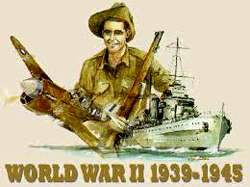The World between Wars 1900-1950 Part-II
 Key Points:
Key Points:
- Tsarist Russia was a vast land mass spread over two continents and making it a Euro-Asian power. It had the third largest population in the world.
- Tsar Nicholas –II ruled over this vast Russian empire like any autocrat with the help of the army and bureaucracy.
- On March 8th 1917 around 10,000 women of the capital, St. Petersburg took out a procession demanding ‘peace and bread’. It was called March Revolution.
- The Bolsheviks were led by Vladimir Lenin (1870-1924). The soviets under the Bolsheviks leadership seized power in November 1917. Full peace could not return to Russian because there started a civil war led by pro-Tsar white armies.
- In 1924, Stalin emerged as the leader of the communist party. USSR began a planned economic development with its five year plans in 1928.
- The great depression began around the end of 1929. It caused massive unemployment and decline of real incomes of across the world, except for the USSR.
- Roosevelt, the president of US announced “The New Deal” which promised relief to the victims of depression reform to financial institutions.
- By 1932, Nazi party had become the largest party in Germany. Hitler mobilised his supporters on the promise of establishing the racial supremacy of Aryan Germans over the world.
-
The first half of the 20th century ended with the nightmare of Hiroshima and Nagasaki and with the hopes generated by the funding of the UNO.
-
Two new super powers emerged on the world scene, the USSR and the USA.
Key words:
- Socialism: A Political and economic theory of social organization which advocates that the means of production, distribution and exchange should be owned or regulated by the community as a whole.
- Communism: A system of social organization in which all property is owned by the community and each person contributes and receives according to their ability and needs.
- Revolution: It is a violent attempt by citizens to end the rule of the government and start a new government which liked by the people.
- Centralization of power: It is one in which power or legal authority is exerted or Co-ordinated itself only is called centralization of power.
- Bolshevik: A group of Russian communist party lead by Vladimir Lenin.
- Collectivization: Consolidate individual land and labour into collective farms so that new techniques and machines could be used. It is a policy adopted by the soviet government, pursued most intensively between 1929 and 1933 to transform traditional agriculture in the USSR and to reduce the economic power of the Kulaks, the landlords of Russia.
- Relief–Reform-Recovery: Former President of US Roosevelt’s Policy based on Keynesian economics, what became to known as the three ‘Rs’ of relief –reform and recovery. This programme generated Jobs.
- Indoctrination: The Process of inculcating ideas, attitudes, cognitive, strategies or a professional methodology.
- Welfare state: The state plays a key role in promotion of the economic and social well-being of its citizens.
- Propaganda: A biased information used to promote a political cause.
- Racial Supremacy: The belief that a particular race is superior to others. Discrimination based on race.
ESSAY ANSWER QUESTIONS
1. Russian revolution brought in many changes in their society. What were they? And what challenges did they face?
I. Russian revolution – Social Changes:
- USSR under the leadership of Stalin tried to end small peasant production by forcing all small and large farmers to surrender their lands and Join ‘Collective Farms’. The idea was to shift from small holding farming to large scale farming.
- All industries were owned by the state which did not allow free market and sold the industrial products to the consumers directly.
- Russia achieved full employment for all its citizens. Literacy and primary education was universalized.
II. Challenges faced by Russia:
- Russia was at World War-I in 1917 with Germany.
- The Russia economy was in shambles.
- The British, French and US refused to recognize their government
- Cheap public health care, low standards of living, resistances were some of the challenges faced by Russia.
2. Compare different points of view about Great Depression which one would you agree with? Why?
- Marxist economists felt that this kind of crises is an essential nature of Capitalism and can be got rid of only with the establishment of socialism.
- JM Keynes argued that the state has a crucial role to play in keeping the economy going and it can lead to situations of depression.
- Keynes argued during time of economic decline that the state should invest funds and to generate employment which will help people to earn many and in turn demand for goods in the market. This generation of demand through state action will help the economy revive.
- Austrian economists argued that the great depression was the inevitable outcome of the monetary policies of the federal revenue during the 1920.
- Milton Friedman and Anna Schwartz laid out their cause for great depression as by the fall of the money supply in their book “A Monetary History of the United States 1867-1960.
- Neo-classical macro economists have argued that various labour market policies imposed at the start caused the length and severity of the great depression.
- Among all points of view about the great depression, I agree with the demand driven theory of Keynes.
- There was no state control over the market forces i.e., demand and supply. The governments of capitalist countries in 1920s and 1930s were reluctant to intervene in the economy and this intensified the crises.
3. In what ways were Jews persecuted during the Nazi Germany? Do you think in every country some people are differentiated because of their identity?
- Nazi ideology depended on majoritarian principles. To build the racial supremacy of Germans they committed mass extermination of minority communities.
- Jews, who numbered about 5,25,000 in Germany were the main target of Nazi Germany. Hitler blamed that Jews were the main cause of all problems. He also said communism and capitalism were conspiracies of Jews.
3. The ways Jews were persecuted:
- In 1933, New Germany laws forced Jews out of their civil service jobs, universities and law court positions and other areas of public life.
- In April 1933, laws proclaimed at Nuremberg made Jews second class citizens.
- Between 1937 and 1939, new anti-Jewish regulations segregated Jews further and made daily life very difficult for them. Jews could not attend public schools go to theatres, cinema, vacation resorts, among other acts.
- Anti–Nazi Jews sent to the death camps and they were killed by gassing in gas chambers or shooting with rifles in gas chambers or shooting with rifles on a large scale in prisons or forests. About 6 million Jews were killed during holocaust.
4. List the measures taken under idea of welfare state under Great Depression and explain how similar or different they are from that of the reforms that emerged under the USSR?
- Roosevelt introduced the much needed social security system in the US. It established a permanent system of universal retirement pensions, unemployment Insurance, and welfare benefits for the handicapped and needy children in families without father present. It also established the frame work for the US welfare system.
- Britain basically announced unemployment insurance and old age pension schemes. It adopted extensive social security measures like unemployment doles, sickness coverage, health schemes, child care etc, All this went on to make the idea of welfare slate in which the state ensured a certain basic minimum dignified life for all citizens and took care of their basic needs.
- The USSR, socialist economy also followed same measures of welfare.
4. What challenges were faced by Germany during Great Depression and how Nazi rulers And Hitler make use of it?
- Germany’s Weimar republic was hit hard by the depression.
- Unemployment so are, especially in larger cities. It reached 30% in 1932.
- Industries, Mills, Production units were shut down in a large scale.
- Aggregate demand and production of goods had sharply come down because lack of capital.
- Unemployed youth desperately queued up at the local employment exchange. As jobs disappeared, the youth took into criminal activities and total despair became common place.
- The economic crisis created deep anxieties and fears in people. The middle classes, especially salaried employees and pensioners, saw their savings diminish when the currency lost its value.
- Small business the self employed and retailers suffered as their business got ruined.
- The large mass of peasantry was affected by a sharp fall in agriculture prices.
- The great depression helped Hitler to come in to power in Germany. Hitler was a powerful speaker. His passion and his words moved people. He promised to built a strong nation, undo the in justice of the Versailles Treaty and restore the dignity of the German people.
- He promised employment for those looking for work and a secure future for the youth. He appealed specially to the middle class which felt threatened by capitalism and the Great depression. So that in 1932, Hitler got 37% voters in the Reichstag and his Nazi Party became the largest party in the parliament.
5. What were the political changes brought under the Nazi rule? Often people argue that a single powerful leader can resolve the problems of a country. Based on the experiences narrated in the context of Nazi Germany how do you respond to this vision?
- Hitler came to power and immediately took steps to establish an undemocratic and autocratic rule and dismantle all democratic institutions.
- The country was turned in to as a dictatorship government Hitler introduced conscription in Germany.
- On 3 March 1933, the famous Enabling Act was passed. It gave Hitler all powers to sideline parliament and rule by decree.
- All political parties and trade unions were banned except for the Nazi party and its affiliates.
- The state established complete control over the economy, media, army and Judiciary.
- Hitler apposed and refused the conditions in the Versailles treaty and with drew the country from the league of Nations.
- Hitler established racial supremacy of Aryan Germans, security forces to control over the society.
Only one decade Nazi party had controlled Germany. But only democratic government can resolve the problems in a peaceful manner.



















